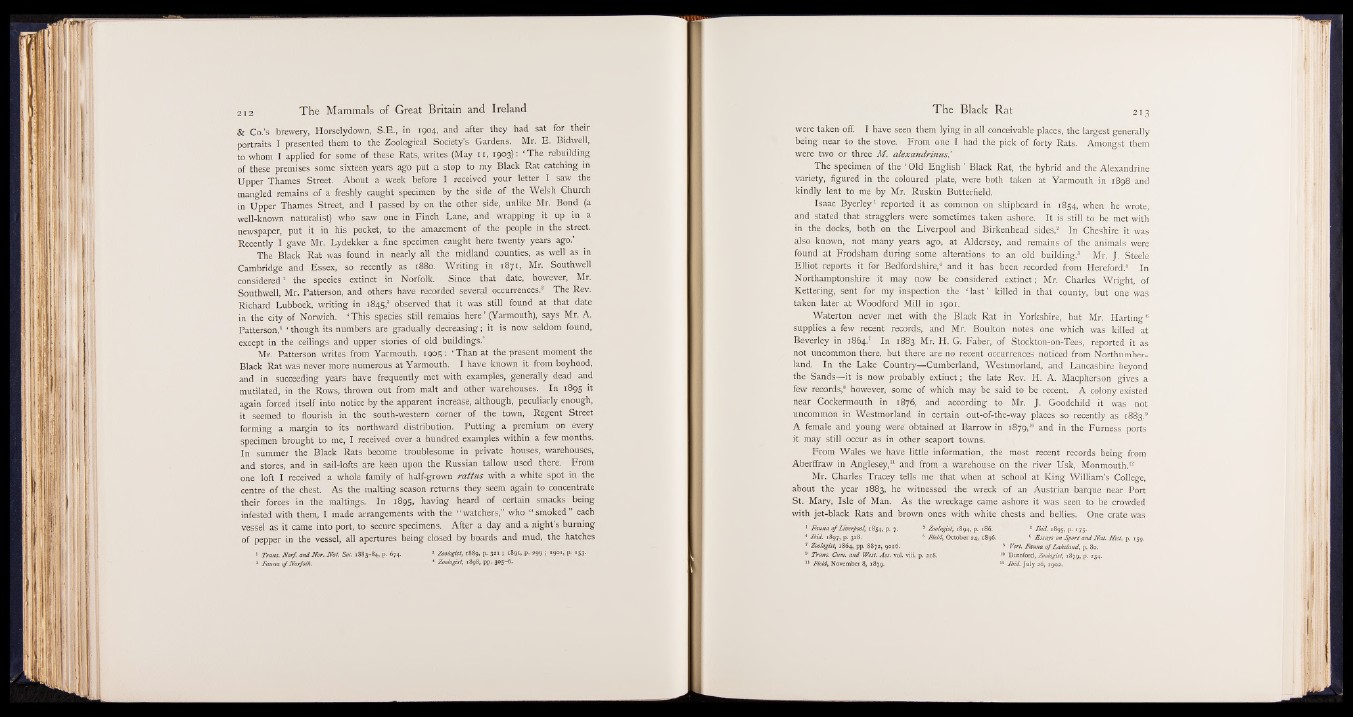
& Co.’s brewery, Horselydown, S.E ., in 1904, and after they had sat for their
portraits I presented them to the Zoological Society’s Gardens. Mr. E . Bidwell,
to whom I applied for some of these Rats, writes (May 1 1 , 1903): ‘ The rebuilding
of these premises some sixteen years ago put a stop to my Black Rat catching in
Upper Thames Street. About a week before I received your letter I saw the
mangled remains Of a freshly caught specimen by the side of the Welsh Church
in Upper Thames Street, and I passed by on the other side, unlike Mr. Bond (a
well-known naturalist) who saw one in Finch Lane, and wrapping it up in a
newspaper, put it in his pocket, to the amazement of the people in the street.
Recently I gave Mr. Lydekker a fine specimen caught here twenty years ago.’
The Black Rat was found in nearly all the midland counties, as well as in
Cambridge and Essex, so recently as 1880. Writing in 1871, Mr. Southwell
considered1 the species extinct in Norfolk. Since that date, however, Mr.
Southwell, Mr. Patterson, and others have recorded several occurrences.2 The Rev.
Richard Lubbock, writing in 1845,8 observed that it was still found at that date
in the city of Norwich. ‘ This species still remains here’ (Yarmouth), says Mr. A.
Patterson,4 ‘ though its numbers are gradually decreasing; it is now seldom found,
except in the ceilings and upper stories of old buildings.’
Mr. Patterson writes from Yarmouth, 1905: ‘ Than at the present moment the
Black Rat was never more numerous at Yarmouth. I have known it from boyhood,
and in succeeding years have frequently met with examples, generally dead and
mutilated, in the Rows, thrown out from malt and other warehouses. In 1895 it
again forced itself into notice by the apparent increase, although, peculiarly enough,
it seemed to flourish in the south-western corner of the town, Regent Street
forming a margin to its northward distribution. Putting a premium on every
specimen brought to me, I received over a hundred examples within a few months.
In summer the Black Rats become troublesome in private houses, warehouses,
and stores, and in sail-lofts are keen upon the Russian tallow used there. From
one loft I received a whole family of half-grown rattu s with a white spot in the
centre of the chest. As the malting season returns they seem again to concentrate
their forces in the maltings. In 1895, having heard of certain smacks being
infested with them, I made arrangements with the “ watchers,” who “ smoked” each
vessel as it came into port, to secure specimens. After a day and a night’s burning
of pepper in the vessel, all apertures being closed by boards and mud, the hatches
1 Trans. Norf. and Nor. Nat. Soc. 1883-84, p. 674. * Zoologist, 1889, p. 327 5 *89*> P- 299 > i9°h p. IS3-
* Fauna o f Norfolk. * Zoologist, 1898, pp. 305-6.
were taken off. I have seen them lying in all conceivable places, the largest generally
being near to the stove. From one I had the pick of forty Rats. Amongst them
were two or three M. alexandrinus.'
The specimen of the ‘ Old English ’ Black Rat, the hybrid and the Alexandrine
variety, figured in the coloured plate, were both taken at Yarmouth in 1898 and
kindly lent to me by Mr. Ruskin Butterfield.
Isaac Byerley1 reported it as common on shipboard in 1854, when he wrote,
and stated that stragglers were sometimes taken ashore. It is still to be met with
in the docks, both on the Liverpool and Birkenhead sides.2 In Cheshire it was
also known, not many years ago, at Aldersey, and remains of the animals were
found at Frodsham during some alterations to an old building.8 Mr. J . Steele
Elliot reports it for Bedfordshire,4 and it has been recorded from Hereford.5 In
Northamptonshire it may now be considered extinct; Mr. Charles Wright, of
Kettering, sent for my inspection the ‘ last’ killed in that county, but one was
taken later at Woodford Mill in 1901.
Waterton never met with the Black Rat in Yorkshire, but Mr. Harting6
supplies a few recent records, and Mr. Boulton notes one which was killed at
Beverley in 1864.7 In 1883 Mr. H. G. Faber, of Stockton-on-Tees, reported it as
not uncommon there, but there are no recent occurrences noticed from Northumberland.
In the Lake Country—Cumberland, Westmorland, and Lancashire beyond
the Sands—it is now probably extinct; the late Rev. H. A. Macpherson gives a
few records,8 however, some of which may be said to be recent. A colony existed
near Cockermouth in 1876, and according to Mr. J . Goodchild it was not
uncommon in Westmorland in certain out-of-the-way places so recently as 1883.9
A female and young were obtained at Barrow in 1879*10 and in the Furness ports
it may still occur as in other seaport towns.
From Wales we have little information, the most recent records being from
Aberffraw in Anglesey,11 and from a warehouse on the river Usk, Monmouth.12
Mr. Charles Tracey tells me that when at school at King William’s College,
about the year 1883, he witnessed the wreck of an Austrian barque near Port
St. Mary, Isle of Man. As the wreckage came ashore it was seen to be crowded
with jet-black Rats and brown ones with white chests and bellies; One crate was
I Fauna o f Liverpool, 1854, p. 7. * Zoologist, 1894, p. 186. 3 Ibid. 1895, p. 175,
* Ibid. 1897, p. 328. 8 Field, October 24, 1896. 6 'Essays on Sport and Nat. Hist. p. 159.
7 Zoologist, 1864, pp. 8872, 9016. 8 Vert. Fauna o f Lakeland, p. 80.
9 Trans. Cum. and West. Ass. vol. viii. p. 2x8. 10 Durnford, Zoologist, 1879, p. 234.
II Field, November 8, 1879. 12 Ibid. July 26, 1902.